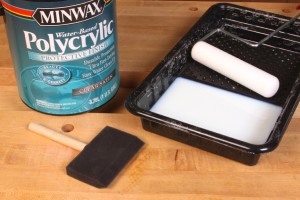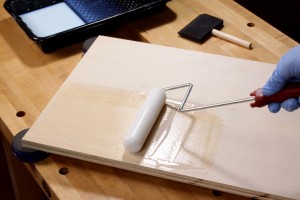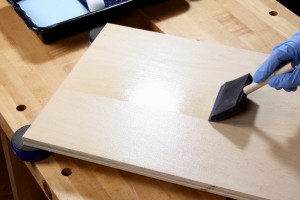 I just wrapped up a project made from almost five sheets of plywood. As you can imagine, that’s a lot of surface area to cover with finish. And, here in the North Country, we’re still in the “deep freeze,” so all of my shop windows and doors are closed up tight. Good ventilation was going to be a challenge during finishing. I also needed to complete the entire finishing process in the shop, which definitely isn’t a “clean room” situation. It’s dusty, especially with the furnace running. So, I knew I’d need a fast-drying finish, too. At least that would help cut down on the magnetic effect that wet finish seems to have on dust and grit.
I just wrapped up a project made from almost five sheets of plywood. As you can imagine, that’s a lot of surface area to cover with finish. And, here in the North Country, we’re still in the “deep freeze,” so all of my shop windows and doors are closed up tight. Good ventilation was going to be a challenge during finishing. I also needed to complete the entire finishing process in the shop, which definitely isn’t a “clean room” situation. It’s dusty, especially with the furnace running. So, I knew I’d need a fast-drying finish, too. At least that would help cut down on the magnetic effect that wet finish seems to have on dust and grit.
After considering my options for a while, I settled on Minwax Polycrylic, because it would satisfy this project’s finishing conundrums pretty well. It dries quickly, has very little odor and is reasonably tough. It also looks good on light-colored woods (mine is maple).
 Now, my usual approach to apply this stuff has been to use a low-nap paint pad. But, I could never figure out a way to keep those tiny, loose whiskers on the pad from getting trapped in the finish. I didn’t want to brush it on and leave brush marks, either. And, with all of that surface area, a speedy solution would be ideal.
Now, my usual approach to apply this stuff has been to use a low-nap paint pad. But, I could never figure out a way to keep those tiny, loose whiskers on the pad from getting trapped in the finish. I didn’t want to brush it on and leave brush marks, either. And, with all of that surface area, a speedy solution would be ideal.
What to do?
Well, I took a risk and tried something different this time: instead of the nappy pad, I grabbed a foam roller—the same kind you use for paint. And, just like paint, I rolled it on. However, I noticed immediately that, while the roller was working swimmingly to lay that finish down fast, it was leaving tiny bubbles behind. Would the bubbles pop out before the finish dried? I wasn’t going to wait and find out.
 Once again, painting tools came to the rescue. As soon as I was done with the roller, I simply took a cheap foam paint brush and tipped off the surface, just barely stroking the edge of the foam along the varnish.
Once again, painting tools came to the rescue. As soon as I was done with the roller, I simply took a cheap foam paint brush and tipped off the surface, just barely stroking the edge of the foam along the varnish.
It worked like a charm. No bubbles, no little bits of whiskers and a very smooth surface in the end. I’m really pleased with it. The next time you’re applying water-based poly, give it a try. Treat it just like paint. It seems to adapt quite nicely.
Catch you in the shop,
Chris Marshall, Field Editor





